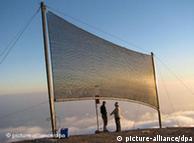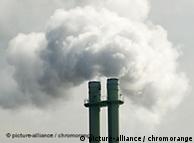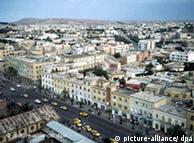Fog is a pesky thing. It tarnishes views, dampens moods and causes accidents.
But at the 5th annual International Conference on Fog, Fog Collection
and Dew held recently in Muenster, Germany, researchers discussed how
fog can also be used as a surprisingly valuable source of clean water,
which with the use of special nets, is relatively easy to come by.
The densely meshed woven nets, which average some 40 square meters in
size, are attached to frames and strategically positioned in places
known to have high fog density. The wind blows the fog - actually just
clouds that touch the ground - into the nets where it deposits droplets
of water that run off into gutters and subsequently collect in a
depository.
As Otto Klemm, the conference host and a professor of climatology at
the University of Muenster, told Deutsche Welle, the technology is
highly effective given the right conditions.
 Bildunterschrift: Großansicht des Bildes mit der Bildunterschrift: A 40 square meter net can collect up to 200 liters of water per day."It
only makes sense where there is a shortage of water and where clouds
pass through without raining," he said, citing the Pacific coast of
northern Chile as one such location. "There is almost always a lot of
fog there so you can hope to collect more than five liters per square
meter per day."
Bildunterschrift: Großansicht des Bildes mit der Bildunterschrift: A 40 square meter net can collect up to 200 liters of water per day."It
only makes sense where there is a shortage of water and where clouds
pass through without raining," he said, citing the Pacific coast of
northern Chile as one such location. "There is almost always a lot of
fog there so you can hope to collect more than five liters per square
meter per day."
That adds up to an average of 200 liters a day, which he says is
plenty to cover the needs of an entire local family. Alternatively, nets
can be used to provide water for agricultural purposes and schools
which currently require pupils to bring their own daily drinking supply.
While various peoples have known about fog collection going back
thousands of years, conservationists are now trying to use nets in areas
around the world that have moisture in the air, but little rain.
In 2006, two German researchers, Kai Tiedemann and Anne Lummerich
pioneered fog net technology in Bellavista, Peru, about 16 kilometers
outside of the capital, Lima. The four meter by eight meter nets they
used could be found at any local hardware store and were relatively
inexpensive. Their work was featured in National Geographic magazine
three years later.
 Bildunterschrift: Großansicht des Bildes mit der Bildunterschrift: Air pollution doesn't make for clean drinking water.Stretching the supply
Bildunterschrift: Großansicht des Bildes mit der Bildunterschrift: Air pollution doesn't make for clean drinking water.Stretching the supply
The Water Foundation, a German charity, has also been involved in a
number of fog collection projects in Eritrea, some specifically aimed at
harnessing drinking water for children. One village put up of 20 fog
nets which collected enough water during the eight months of rain and
fog in the region to keep two schools and 120 families in constant
supply.
As Ernst Frost of the foundation told Deutsche Welle, the method
provides a fantastic alternative for communities which ordinarily have
to dig wells, walk miles up and down mountains to collect valley water
or have to pay significant amounts of money for water sold off the back
of tankers.
But how clean is it? That is an issue which comes up over and over
again in the context of fog collection and Klemm says quality varies
from place to place.
"In some areas it is safe, in others like Chile, there are power
plants and mining plants that emit lots of air pollution, so we need
quality controls."
Although that requires some initial financial outlay, once the fog
for a specific area has been given the all-clear, the costs involved in
its capture are negligable.
According to the Canadian charity, Fog Quest, its 40 square-meter net
costs between 775 euros ($1,000) and 1,100 euros, and can last for up
to ten years.
 Bildunterschrift: Großansicht des Bildes mit der Bildunterschrift: The Eritrean capital of Asmara could benefit from fog capture in the future.Maintaining the nets remains a constant battle
Bildunterschrift: Großansicht des Bildes mit der Bildunterschrift: The Eritrean capital of Asmara could benefit from fog capture in the future.Maintaining the nets remains a constant battle
Despite all of this potential success, there's also a slight problem, according to Ernst Frost.
"If there are strong winds and the nets tear, they need to be
stitched up," he said. "But people don't yet feel responsible enough for
them to do that."
He noted in the case of Eritrea in particular, that lack of a sense
of ownership is not a result of not caring, but simply of having other
things to worry about.
"A lot of people, men and women, are away from the villages doing
their military service, so the population of these places is largely
comprised of young mothers, children and old people," he said, adding
that they are too preoccupied with day-to-day survival to think about
patching holes in nets.
Klemm agrees that getting local populations to understand the
importance of fog capture is vital if the practise is to be expanded and
have any long-term future.
"The biggest challenge is convincing people to do it, to make them
understand that there is a fresh water source that has been here for
2,000 years without being used."
But through good communication and the support of local and national
governments, he is hopeful that many more people without ready access to
clean water will come to recognise that fog has a silver lining.
Reporter: Tamsin Walker
Editor: Cyrus Farivar
http://www.dw-world.de/dw/article/0,,5918010,00.html












